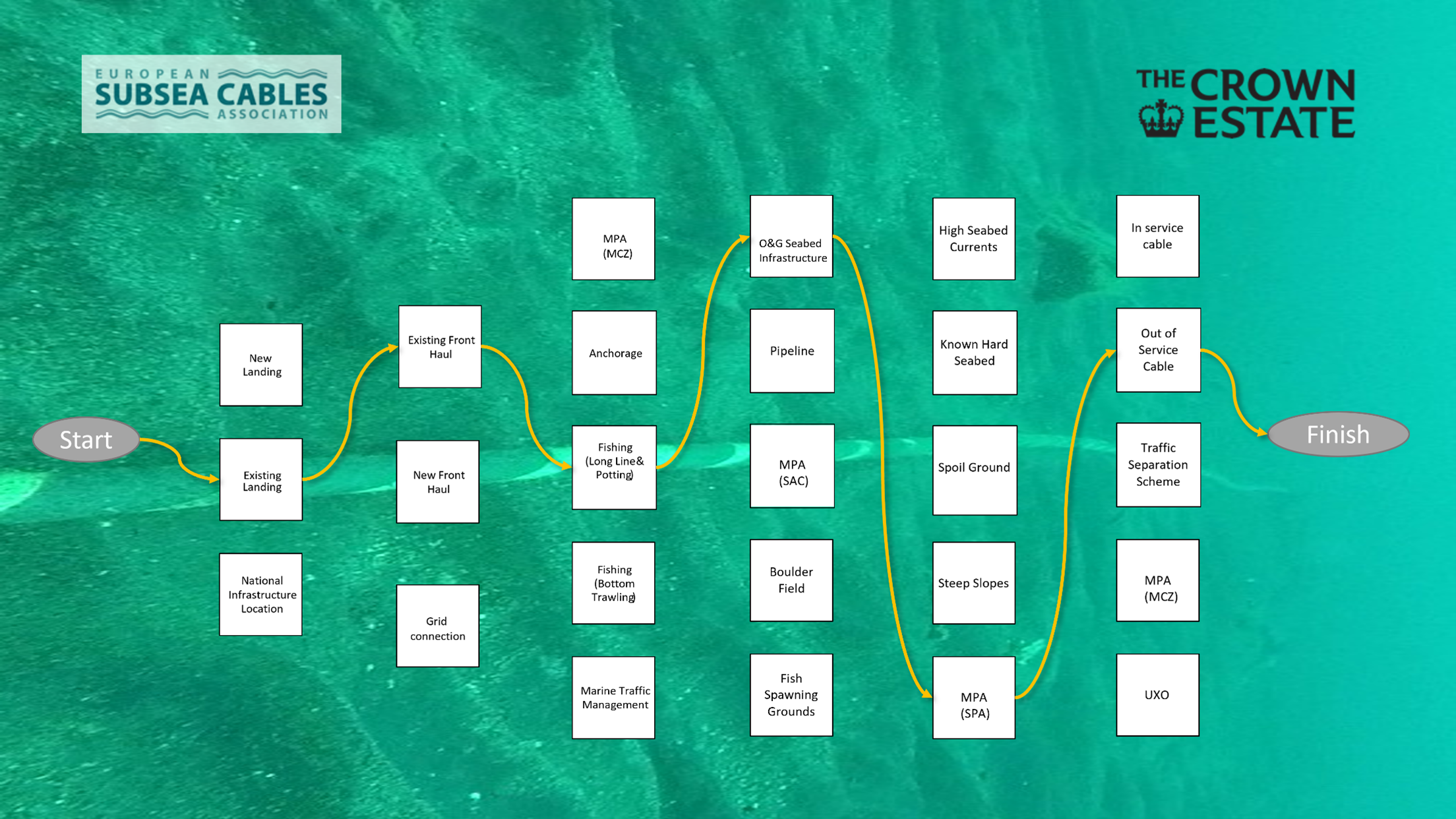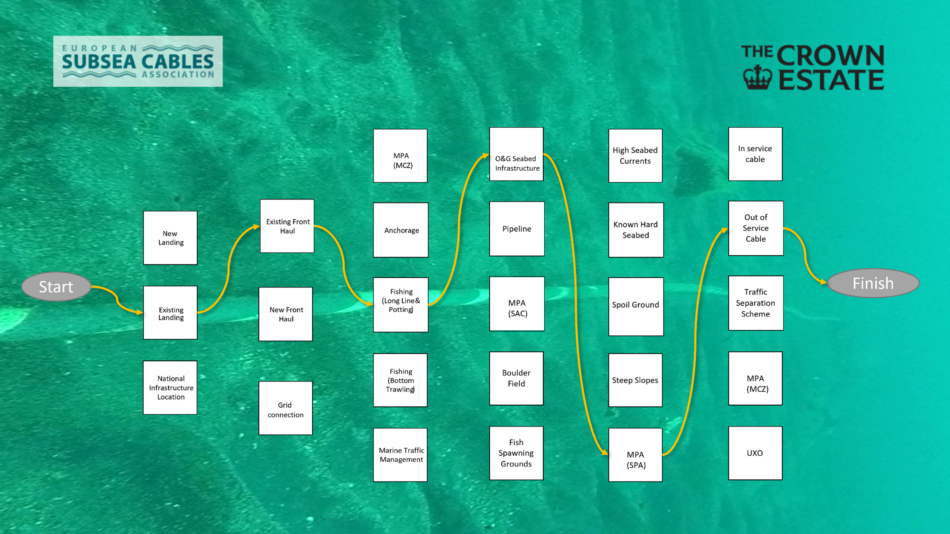Contact Us
Tuesday 1st August 2023 | Blog written by James Rygate, Route Engineer

On Tuesday 27 June, The Crown Estate (TCE) and the European Subsea Cables Association (ESCA) hosted an interactive workshop designed as an introduction for newcomers to the subsea cable industry along with those looking to refresh their knowledge. This virtual event was led by qualified professionals and aimed to guide attendees through some of the complexities of a subsea cable ecosystem. The primary objective was for the attendees to come away with a greater understanding of the workings and relationships between regulators, governmental bodies, licensing and other stakeholders, and the overlapping and often complex constraints facing cables laid under the sea.


The workshop was split into four sessions across two days, and each session entailed a combination of learning, open discussion, short activities and networking. On behalf of OceanIQ, myself and three colleagues Alex Riddell (Permitting Manager), Chloe Morris (Permitting Support Officer) and James Georgiev (Graduate Route Engineer) each facilitated separate sessions which composed of a high-level route engineering exercise. In these workshops, attendees assessed a matrix of risks that frequently present themselves when engineering the route of a new subsea cable system in a real-life situation. Working through each column of risks in the matrix, the impacts were discussed, and decisions were made to plan a cable route focussing mostly on system integrity and minimising delays to the project.
With a group consisting of individuals from both environmental and power cable backgrounds, you can see the steps that we took as part of the exercise below:

The first step was to decide whether the route we were designing would be a fibre optic or power cable. Based the expertise and industry roles of the attendees in the room, we agreed on power. From here, we decided to use an existing landing as this had the benefits of requiring less construction works to build a new beach manhole.
Utilising an existing landing lent itself naturally to also using an existing front haul too, as in this case the onshore infrastructure between the beach manhole and cable landing station are already in place. Constraints such as land ownership to design a new front haul are therefore negated.
Arriving at the first group – offshore hazards – bottom trawling areas and anchorages were dismissed immediately by the attendees in the room as they present a very high risk to a subsea cable and are indeed the two biggest causes of cable faults worldwide.
Avoiding the Marine Protected Area (MPA) was also a strong preference as the area in question for route planning purposes was designated for chalk. This feature cannot geomorphologically recover from direct impacts such as cable trenching.
Unlike bottom trawling, pots & traps and longlining are not directly seabed invasive and pose less risk to a submarine cable. Static gear may disrupt survey and installation activities; however, a pre-lay grapnel run can be carried out prior to installation to clear the route of obstructions. For these reasons the fishing areas where longlining and potting are present were chosen for the cable route.
From the second group of offshore hazards, oil & gas infrastructure was chosen for route planning. This is because hydrocarbon infrastructure is generally straightforward to route around and is often marked on navigation charts or identified in the marine survey.
The MPA was again avoided since in this example it was designated for the protection of subtidal sandbanks. Sandbanks are highly mobile features and although they are likely to recover from cable trenching operations, there is a risk of a buried cable becoming exposed at a later date.
Boulder fields present a risk of suspension of damage to the cable plough, while a pipeline may involve a detailed crossing methodology (e.g., rock placement or concrete mattresses) as well as a Crossing Agreement between the cable and pipeline owners.
Fish spawning grounds may be sensitive or designated and were avoided to remove the need for additional investigation in the form of an environment impact assessment.
Working through the third group of offshore hazards, the Marine Protection Area (MPA) in this case was deemed the lowest risk to the submarine cable system. This designation was a Special Protection Area (SPA) for bird species. Breeding seasons can be easily avoided at the operational planning stage and birds are generally less sensitive to cable laying operations compared to other protected seabed features or marine species.
High seabed currents can pose a challenge to installation and an increased stability risk for a surface laid cable, leading to future abrasion damage. Similarly, hard seabed substrates are also an abrasion risk and should be avoided if at all possible.
Steep slopes are unlikely to damage the cable directly but may be a limiting factor in using a plough burial for instability reasons.
Spoil grounds present a risk of dredged material being deposited onto the cable route, causing damage. The nature of the seabed at spoil ground sites is also often unclear, and so these should be avoided where possible.
The final stage resulted in perhaps the most straightforward decision of the workshop, with the out of service cable crossing selected for route planning. Once the cable owner has been identified, out of service cables are simply cleared according to standard industry procedures so that the new route can be laid through the corridor.
An in-service cable crossing is more complex than an out of service cable crossing in that a Crossing Agreement is usually required, as well as additional protection at the crossing point to protect both cables from damaging one another.
Traffic Separation Schemes are high density shipping lanes that lead to major port and harbour infrastructure. Not only do these areas have a higher risk of anchor damage from large merchant vessels, but there is also a maritime safety aspect associated a slow-moving cableship in a high-traffic area during installation operations.
The final MPA for consideration in the workshop was a Marine Conservation Zone (MCZ) designated for multiple broad-scale habitats including coarse sediments, sands and muds. These are usually moderately sensitive to disturbance and come with conservation objectives to maintain the current status of the habitat.
Lastly, unexploded ordnance (UXO) should always be avoided as it creates major installation challenges and may require additional UXO risk assessments to be carried out. A possible UXO survey might also need to be conducted.
Throughout the workshop there was an emphasis on the idea that there are no right or wrong answers to each set of hazards. There are many different drivers behind engineering the optimum submarine cable route such as risk of damage to the cable itself, residual risk to the marine environment, disruption to other seabed users and negotiating natural seabed features such as rock outcrops and sandwaves.
Overall, the workshop was well-received by the attendees across all sessions. I found that it was a fantastic opportunity to outline to other industry professionals some of the main complexities faced by submarine cable route planning which is something that our team at OceanIQ deal with on a daily basis.
Thanks to ESCA and The Crown Estate for involving us, and we hope to see more of the same in the future.
